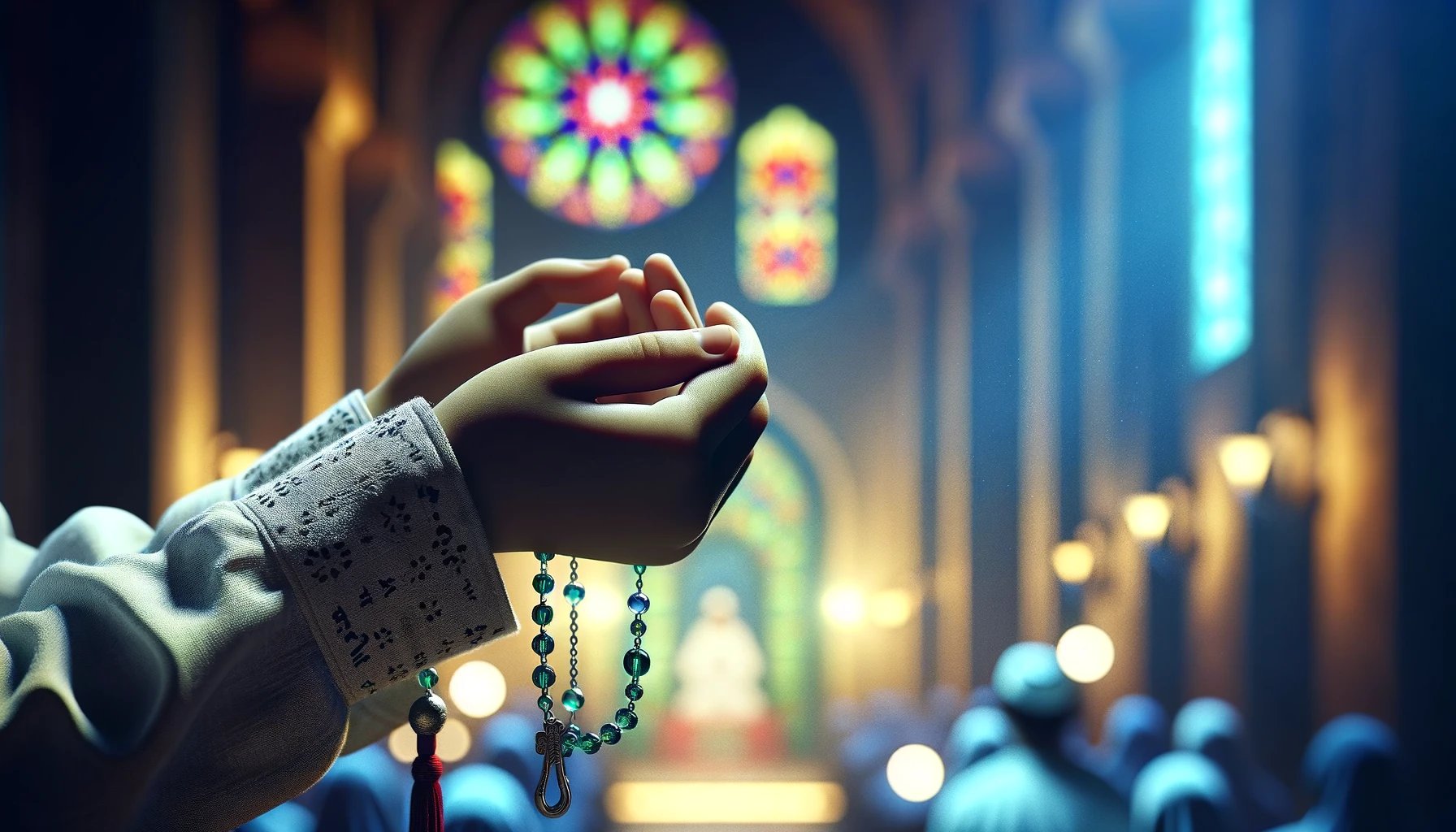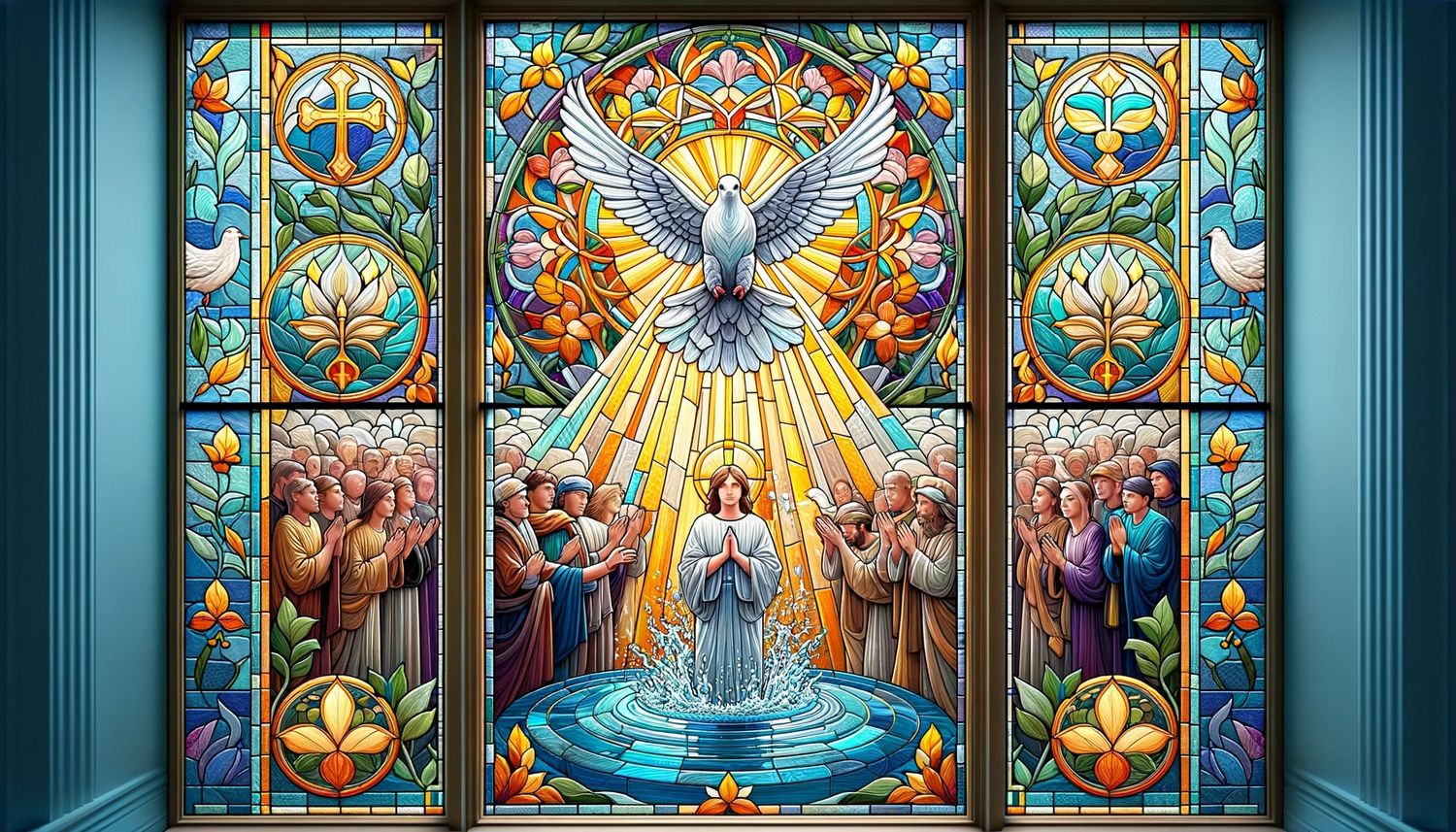Home>Theology and Spirituality>How Do You Wish For Baptism


Theology and Spirituality
How Do You Wish For Baptism
Published: February 29, 2024
Peter Smith, Editorial Director at Christian.net, combines deep insights into faith, politics, and culture to lead content creation that resonates widely. Awarded for his contributions to religious discourse, he previously headed a major organization for religious communicators, enhancing dialogue on faith's societal impacts.
Discover the significance of baptism and learn how to express your wishes for this sacred ceremony. Explore theology and spirituality in the context of baptism.
(Many of the links in this article redirect to a specific reviewed product. Your purchase of these products through affiliate links helps to generate commission for Christian.net, at no extra cost. Learn more)
Table of Contents
The Significance of Baptism
Baptism holds a significant place in many religious traditions, symbolizing the initiation of an individual into the faith community. It is a sacred rite that marks the beginning of a person's spiritual journey and their commitment to their religious beliefs. The act of baptism is deeply symbolic, representing purification, rebirth, and the washing away of sin. It is a powerful and meaningful ceremony that is central to the religious identity of many individuals and communities. Here are some key aspects that highlight the significance of baptism:
-
Spiritual Cleansing: Baptism is often associated with the idea of spiritual cleansing. It is believed to wash away the original sin and symbolize the individual's purification and rebirth into a new life within the religious community.
-
Initiation into the Faith: For many Christian denominations, baptism is the sacrament through which a person becomes a member of the Church. It signifies their acceptance into the religious community and their commitment to living according to the teachings and principles of their faith.
-
Symbol of Faith: Baptism serves as a public declaration of an individual's faith. It is a visible and symbolic expression of their belief in the religious doctrines and their desire to live a life guided by those beliefs.
-
Receiving Divine Grace: In various religious traditions, baptism is seen as a means of receiving divine grace. It is believed to be a moment when the individual is touched by the presence of the divine and is blessed with spiritual strength and guidance.
-
Family and Community Celebration: Baptism is often a joyous occasion celebrated within the family and the religious community. It brings together loved ones and fellow believers to witness and participate in the initiation of a new member into the faith.
-
Eternal Salvation: In some Christian traditions, baptism is linked to the concept of eternal salvation. It is seen as a necessary step for the individual to attain salvation and entry into the kingdom of heaven.
-
Symbol of Unity: Baptism can also symbolize unity within the religious community. It serves as a unifying ritual that connects individuals across generations and cultures, reinforcing the sense of belonging and shared faith.
The significance of baptism extends beyond the physical act of immersion in water or the pouring of water over the individual. It is a deeply spiritual and symbolic ritual that holds profound meaning for those who undergo it and for the religious communities to which they belong.
Read more: How To Do A Baptism
Preparation for Baptism
-
Understanding the Significance: Before the baptism ceremony, it is essential for individuals and their families to understand the significance of this sacred rite. They should familiarize themselves with the beliefs and practices associated with baptism in their specific religious tradition. This understanding helps in approaching the ceremony with reverence and appreciation for its spiritual importance.
-
Spiritual Readiness: Preparation for baptism often involves spiritual readiness. This may include engaging in prayer, reflection, and seeking guidance from religious leaders. It is a time for individuals to introspect and reaffirm their commitment to their faith, ensuring that they are spiritually prepared for the responsibilities that come with being baptized.
-
Instruction and Education: Many religious traditions offer instruction and education for individuals preparing for baptism, especially in the case of infant baptism. Parents and guardians are often encouraged to participate in classes or sessions that provide insight into the significance of baptism and the role they play in nurturing the spiritual growth of the child.
-
Choosing a Baptismal Name: In some traditions, individuals are given the opportunity to choose a baptismal name, which may hold personal or religious significance. This name becomes associated with their identity within the faith community and is often used during the baptismal ceremony.
-
Selection of Godparents: For infant or child baptisms, the selection of godparents is an important aspect of preparation. Godparents are chosen to provide spiritual guidance and support to the child as they grow in their faith. The process of selecting godparents involves careful consideration and may include discussions with religious leaders.
-
Logistical Arrangements: Practical arrangements, such as scheduling the date and time of the baptism, coordinating with the religious institution or officiant, and preparing the necessary ceremonial items, are also part of the preparation process. This ensures that the baptism ceremony can proceed smoothly and with the appropriate religious elements in place.
-
Celebratory Planning: Families often engage in planning celebratory gatherings or meals to mark the occasion of baptism. This may involve inviting friends and family members to join in the celebration, further emphasizing the communal significance of the event.
-
Emotional and Mental Preparation: Individuals and families may also engage in emotional and mental preparation for baptism, recognizing the emotional significance of the ceremony and the impact it may have on their spiritual lives. This can involve discussions about the meaning of baptism and the role it plays in shaping their religious identity.
The preparation for baptism encompasses a range of spiritual, practical, and emotional considerations, all of which contribute to the meaningful and reverent observance of this important religious rite.
Choosing a Godparent
-
Spiritual Guidance and Support: The selection of a godparent is a crucial aspect of the baptism process, particularly in traditions that practice infant or child baptism. A godparent is chosen to provide spiritual guidance and support to the child as they grow in their faith. The role of the godparent extends beyond the baptism ceremony, as they are expected to play an active part in the child's religious upbringing and moral development.
-
Qualities and Characteristics: When choosing a godparent, individuals and families often consider certain qualities and characteristics that are desirable in a mentor and spiritual guide. These may include strong moral values, a deep commitment to the religious faith, and a genuine interest in the well-being and spiritual growth of the child. The godparent is expected to serve as a positive role model and source of wisdom for the child.
-
Religious Affiliation and Commitment: In many religious traditions, the godparent is required to be a practicing member of the same faith community as the child being baptized. This ensures that the godparent can actively participate in the child's religious education and provide consistent support within the context of the shared religious beliefs and practices.
-
Relationship with the Family: The selection of a godparent often involves considering the individual's relationship with the family. Godparents are typically chosen from within the family or close circle of friends, as this fosters a sense of trust and familiarity. The godparent should be someone who is willing to invest time and effort in nurturing a meaningful relationship with the child and their family.
-
Responsibilities and Commitment: Prospective godparents should be aware of the responsibilities and commitment involved in fulfilling the role. This may include actively participating in the child's religious education, providing moral and spiritual guidance, and being present for significant milestones in the child's life. The godparent is expected to be a supportive presence in the child's journey of faith.
-
Discussion with Religious Leaders: In some traditions, the selection of godparents may involve discussions with religious leaders or clergy members. These discussions can provide guidance on the qualities and expectations associated with the role of a godparent, ensuring that the selection aligns with the religious teachings and principles of the faith community.
-
Ceremonial Role: During the baptism ceremony, the godparent participates in the ritual by making promises on behalf of the child and offering their support in the child's spiritual upbringing. This ceremonial role underscores the significance of the godparent's commitment to the child's religious development.
-
Continued Involvement: The relationship between the godparent and the child is intended to be enduring, extending beyond the baptism ceremony. Godparents are encouraged to maintain regular contact with the child, offering guidance, support, and encouragement as the child grows in their faith and understanding of religious principles.
The selection of a godparent is a thoughtful and significant decision, reflecting the desire to provide the child with a supportive and nurturing spiritual mentor. It is a role that carries deep meaning and responsibility within the context of religious upbringing and community.
The Baptism Ceremony
The baptism ceremony is a sacred and significant event that marks the formal initiation of an individual into the religious community. It is a deeply symbolic and reverent occasion, rich with spiritual meaning and tradition. The ceremony typically involves a series of rituals and prayers, each carrying its own significance within the context of the religious faith. Here are the key elements that characterize the baptism ceremony:
-
Gathering and Welcome: The ceremony often begins with a gathering of the individual being baptized, their family, friends, and members of the religious community. A warm welcome sets the tone for the solemn yet joyous occasion, emphasizing the communal nature of the event and the support of the faith community.
-
Opening Prayers and Readings: The ceremony may include opening prayers and readings from religious texts, setting the spiritual tone and invoking blessings upon the individual being baptized. These prayers often seek divine guidance and grace for the one about to undergo the sacrament of baptism.
-
Renunciation of Sin and Profession of Faith: In many Christian traditions, the baptismal candidate, or their parents and godparents in the case of infant baptism, renounces sin and professes their faith in the presence of the congregation. This declaration signifies a commitment to living according to the teachings and principles of the faith.
-
Blessing of the Water: The water used in baptism is blessed by the officiating clergy, signifying its sanctification for the purpose of spiritual purification and rebirth. The act of blessing the water holds deep symbolic significance, representing the cleansing of sin and the beginning of a new life in the faith.
-
Immersion, Pouring, or Sprinkling: The method of administering the water varies among different Christian denominations. Some practice immersion, where the individual is fully immersed in water, symbolizing a complete cleansing and rebirth. Others use pouring or sprinkling of water, each carrying its own symbolic meaning within the context of the sacrament.
-
Anointing with Oil: In some traditions, the individual being baptized is anointed with holy oil as a sign of consecration and the bestowal of the gifts of the Holy Spirit. This anointing represents the sealing of the baptized person with the presence and strength of the divine.
-
Receiving of a White Garment: Symbolizing purity and the new life in the faith, the baptized individual may receive a white garment as a visible sign of their spiritual transformation and their incorporation into the religious community.
-
Lighting of the Baptismal Candle: The lighting of a baptismal candle from the Paschal candle, representing the light of Christ, is a common ritual in many baptism ceremonies. This act symbolizes the enlightenment and guidance received through the faith, illuminating the path of the baptized individual.
-
Prayers of Thanksgiving and Blessings: The ceremony concludes with prayers of thanksgiving, blessings, and well-wishes for the newly baptized individual. The congregation often joins in expressing joy and support for the one who has undergone this significant rite of passage.
The baptism ceremony is a profound and sacred observance, rich with symbolism and spiritual significance. It serves as a pivotal moment in the life of the individual, marking their formal entry into the religious community and their commitment to a life guided by faith and spiritual values.
Post-Baptism Traditions and Celebrations
After the solemn and sacred observance of the baptism ceremony, many religious traditions incorporate post-baptism traditions and celebrations that hold cultural and communal significance. These traditions and celebrations serve to mark the joyous occasion of the individual's initiation into the faith community and to reinforce the bonds of family and religious fellowship. Here are some common post-baptism traditions and celebrations that are observed in various religious contexts:
-
Reception and Gathering: Following the baptism ceremony, it is customary for the family and the religious community to gather for a reception or a celebratory meal. This gathering provides an opportunity for loved ones and fellow believers to offer their congratulations and support to the newly baptized individual and their family. It fosters a sense of communal joy and solidarity, emphasizing the significance of the event within the religious community.
-
Gift-Giving: In many cultures, the tradition of gift-giving is observed after the baptism. Family members, friends, and godparents may present the newly baptized individual with symbolic gifts that hold religious or sentimental value. These gifts may include religious tokens, such as a cross or a Bible, as well as keepsakes that commemorate the occasion. The act of giving and receiving gifts serves as a gesture of love and support for the individual's spiritual journey.
-
Feast Days and Special Observances: Some religious traditions designate specific feast days or special observances to commemorate the baptism of an individual. These occasions may be celebrated annually within the religious calendar, serving as a reminder of the significance of the baptism and the ongoing spiritual growth of the baptized individual. Such observances often involve prayers, blessings, and communal gatherings that reaffirm the individual's place within the faith community.
-
Naming Ceremonies and Traditions: In cultures where the baptismal name holds particular importance, post-baptism traditions may include naming ceremonies or rituals that honor the significance of the chosen name. This may involve the formal announcement of the baptismal name within the religious community, accompanied by prayers and blessings for the individual's spiritual journey under their new name.
-
Cultural Customs and Practices: Post-baptism celebrations often incorporate cultural customs and practices that reflect the traditions of the community to which the baptized individual belongs. These customs may include music, dance, traditional attire, and other cultural expressions that add richness and diversity to the celebration, emphasizing the unity and diversity within the religious community.
-
Continued Religious Education and Guidance: After the baptism, there is often an emphasis on continued religious education and guidance for the newly baptized individual. This may involve participation in religious classes, mentorship programs, and ongoing support from the godparents and the religious community. The post-baptism period serves as a time for nurturing the individual's spiritual growth and understanding of their faith.
-
Prayers and Blessings: The period following the baptism is marked by prayers and blessings offered for the well-being and spiritual development of the newly baptized individual. These prayers may be offered by family members, godparents, and the religious community, seeking divine guidance and grace for the individual's journey in the faith.
-
Acts of Service and Charity: In some religious traditions, post-baptism celebrations may include acts of service and charity as a way of expressing gratitude for the blessings received through the sacrament of baptism. This may involve community outreach, charitable donations, or volunteer work that reflects the values of compassion and goodwill inherent in the religious teachings.
Post-baptism traditions and celebrations vary across different religious and cultural contexts, each carrying its own unique significance and symbolism. These observances serve to honor the spiritual milestone of baptism and to reinforce the bonds of faith, family, and community, marking the beginning of the individual's journey as a member of the religious community.















